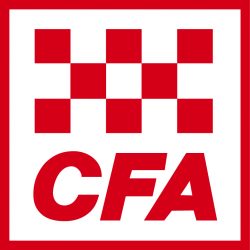Captain Stan Parker resigned in August 1950, and was succeeded by Jim White who had enrolled as a firefighter in August 1942. Jim had been appointed Secretary within the first few months of the foundation of the Brigade and had served continuously in that capacity until his election as Captain.
The year 1950 also saw the formal beginnings of an organisation on which the Brigade was to rely heavily for support: a small group of ladies had banded together to work for the Brigade as its Ladies’ Auxiliary. Although this was the Committee’s official foundation, the ladies’ self assumed task of assisting the Brigade was a continuation of the work, which they and their predecessors had carried out as far back as the origin of the Bush Fire Brigade.
For year after year the members of the Ladies’ Committee have worked cheerfully and diligently to raise much needed funds for the Brigade, to improve the welfare of its members, and to organise catering services during major operations. In good times and in bad, and often without the public recognition, which is rightfully theirs, these ladles have staunchly supported the Brigade throughout the years. The names of the Committee Presidents, and the Committee of today appear in Appendices “E” and “F”.
The development of the district during the fifties placed an even increasing demand on the reticulated water supplies, and on hot days many of the mains in the town would often be empty for hours on end.
To meet this problem, and that of insufficient water supplies in the towns throughout the hills, the Brigade devised a technique that utilised the pumper, in conjunction with a series of tankers, to deliver an effective volume of water to major structure fires. Dubbed “Gunga-Din” (after Kipling’s immortal water carrier), the highly co-ordinated process was perfected through constant practice and it was used with considerable success in actual operations.
In April 1955, after five years as leader, Jim White relinquished the Captaincy and handed over the reins to his successor, Lieutenant Ray Parker. Having joined the Brigade at its inaugural meeting, Ray had served continuously, except for his war service with the RAAF, and had held, successively, the offices of Apparatus Officer, Foreman and Lieutenant.
Work was now forging ahead with the new fire station on which the Authority had begun construction in 1954. After rectifying the problem with the eastern boundary line (which was somewhere under the adjoining house) and after certain misadventures with the concrete facade of the building (which wouldn’t stay up), the new brick station was formally opened in September 1956. The old station was moved to the back yard and used as a store shed.
At this time the Brigade was elevated to “C” Class, permitting it to increase the establishment to twenty-five active firefighters and sixteen reserves.
A new Series 3 Austin front-mounted pumper was placed in service at Ferntree Gully in the latter part of 1956 to replace the Ford unit, which had served the Brigade well over the past decade.
Still confined in its operations to incidents served by either an unreliable reticulated water supply, or by static water supplies, the Brigade discussed the subject of a tanker with the Authority, and the decided to proceed on its own with the purchase of such a vehicle.
After negotiations with an oil company in 1957, the Brigade acquired a 1942 model, 650-gallon capacity, six-wheel drive GMC tanker. Formerly an oil tanker used originally by the U.S. Army Air Force in its wartime aerodromes in the Pacific, the “Gimmy” (as it was christened) was to make quite an impression on the Brigade’s striking power. Placed in service in December 1957, the truck proved to be quite a boon in our hilly terrain, and it was frequently called upon for support in larger fires throughout the hills.
The design limitations of the vehicle restricted the crew to seven men: the driver, two seated passengers (all of whom travelled without the unnecessary encumbrance of doors) and two more men riding on each running board. Because the vehicle presented such a fearsome sight to other road users, warning devices were considered redundant, but an old police siren was acquired from a rather dubious source. The place of signal honour for any red-blooded firefighter travelling to a fire on the GMC was the offside running board from where he would operate the siren switch for the drover.
A base radio station was established in 1957 in Captain Parker’s home in The Glen to co-ordinate the Brigade’s fire-fighting operations. Working initially on the old Dandenong Ranges Group frequency of 4520 kcs, the station was operated jointly by Ray and his wife Shirley under the call sign VLJFQ. Shirley distinguished herself by the competent manner in which she operated the base during many an irregular watch for hours and, on occasion, for days at length.
Captain Parker resigned from office in June 1958, and was succeeded by Jim Dinsdale who had joined the Brigade in 1944 and had served as Lieutenant since 1955. Jim was to lead the Brigade through one of its most trying periods until when, in July 1962, he was promoted to the staff of the Authority as Regional Officer.
The Austin appliance, which had seen four years service with the Brigade, was replaced in April 1960 by a later model Austin pumper fitted with “first aid” water tank and hose reel, in addition to its normal complement of canvas hose. This vehicle was to remain in service until 1969.
